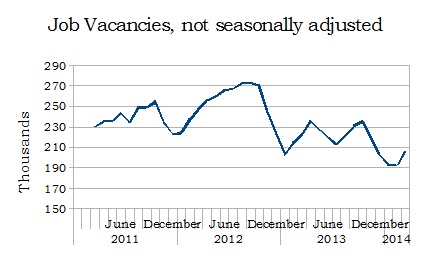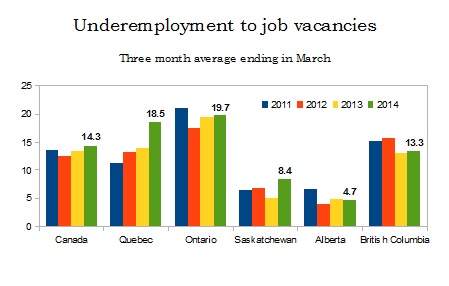Job Vacancies Falling
The number of job vacancies recorded by Statistics Canada are at a four year low (job vacancy data collection began in January 2011). The number of unemployed persons has changed very little, and so we have a relatively high number of unemployed persons per job vacancy.
Even though the data is not seasonally adjusted, you can see an overall trend toward fewer job vacancies, especially since 2012.
As of March 2014, there were only 206,000 job vacancies for nearly 1.4 million unemployed workers in Canada, giving us 6.8 unemployed workers for every job vacancy. If you add underemployment into the mix, there were 2.9 million underemployed workers in Canada in March 2014 (three month average, seasonally unadjusted). That gives us a national underemployment to job vacancy ratio of 14.3.
There are very different trends in Ontario and Quebec. You can see that while Ontario has a higher number of underemployed workers per job vacancy than Quebec, this number is slightly better than it was in March 2011. On the other hand, Quebec’s ratio is higher in each subsequent March, and much higher in March 2014 than it was in March 2013.
Saskatchewan and Alberta boast relatively low ratios, but Saskatchewan saw a marked rise over last year. British Columbia’s unemployment to job vacancy ratio improved between March 2013 and March 2014, but their *underemployment* ratio worsened slightly.
If you’re interested in the number of underemployed workers in your province, and the resulting underemployed worker to job vacancy ratio, I’ve calculated the most recent numbers here.
| March 2014 | |||
| Seasonally unadjusted 3 month average | |||
| Underemployed | Job Vacancies | Ratio | |
| Canada | 2,946,545 | 206,200 | 14.3 |
| Newfoundland & Labrador | 65,821 | 2,700 | 24.4 |
| PEI | 19,561 | 500 | 39.1 |
| Nova Scotia | 96,907 | 4,400 | 22.0 |
| New Brunswick | 81,909 | 4,000 | 20.5 |
| Quebec | 684,505 | 37,100 | 18.5 |
| Ontario | 1,246,309 | 63,400 | 19.7 |
| Manitoba | 91,137 | 11,100 | 8.2 |
| Saskatchewan | 58,459 | 7,000 | 8.4 |
| Alberta | 216,606 | 46,300 | 4.7 |
| British Columbia | 383,557 | 28,800 | 13.3 |
If these numbers sound outrageous, that’s because they are. Recently in Nova Scotia, Giant Tiger received nearly 400 applications for 50 job openings. From the article: “Every individual that applied had great background in retail.”
Keep these numbers in mind this week (or next) as Jason Kenney announces changes to the Temporary Foreign Worker program, and every time an employer claims that they are unable to find workers in Canada.



So, if I’m reading this right, you’re saying that their are fewer jobs available in Canada than their used to be, but unemployment/underemployment hasn’t really changed?
Jordan, that’s pretty much it. Underemployment and unemployment has changed over the period, but proportionally job vacancies have fallen much more.
The Broadbent Institute has just called for a Youth Job Guarantee. Letter in National Post below supports such action. A full Job Guarantee is actually a macroeconomic policy framework designed to ensure full employment and price stability over the private sector business cycle. See Job Guarantee (http://mmtincanada.jimdo.com/policy-issues/job-guarantee/) for details.
Finding work for youth
http://fullcomment.nationalpost.com/2014/06/28/saturday-letters-court-confirms-that-most-canadians-are-second-class-citizens/
Re: Fight Youth Unemployment By Cutting Red Tape, Marni Soupcoff, June 26
At a time when Canadian businesses are sitting on billions in “dead money†and will not invest because there is not enough demand for their products, it is fatuous to suggest hundreds of thousands of students can find employment through setting up mac and cheese food trucks.
Lack of demand also existed during the Great Depression, but that problem ended with massive government war spending that hired one of three adult males to serve in the armed forces, brought the unemployment rate down to 1%, achieved military victory and bequeathed a post-war economy that was more productive, with a well-disciplined and motivated workforce.
Today the federal government must step in and put young people to work in areas such as teaching the young, ministering to the aged, offering arts performances to the public, and cleaning up the environment. This can be done in a decentralized way by funding non-profits, community groups and lower levels of government. Canada loses when its young people fail to get work experience or learn skills, lack income, suffer psychologically and are denied an opportunity to contribute to society.
Larry Kazdan, Vancouver
Footnotes:
1. The Job Guarantee: A Government Plan for Full Employment
http://www.thenation.com/article/161249/job-guarantee-government-plan-full-employment
The benefits of full employment include production of goods, services and income; on-the-job training and skill development; poverty alleviation; community building and social networking; social, political and economic stability; and social multipliers (positive feedbacks and reinforcing dynamics that create a virtuous cycle of socioeconomic benefits). An “employer of last resort†program would restore the government’s lost commitment to full employment in recognition of the fact that the total impact would exceed the sum of the benefits.
2. 1939–1945: World War II Transformed the Canadian Economy
http://web.archive.org/web/20050507140447/http://canadianeconomy.gc.ca/english/economy/1939ww2.html
The government budget deficit also increased rapidly: in 1939, the budget deficit was less than 12% of GNP; in 1945, that rate rose above 42%. Nevertheless, by 1944, the Great Depression had faded into memory, and the unemployment rate was less than 1%.
By the end of the war, the economy had a more highly skilled labour force, as well as institutions that were more conducive to sustained economic growth.
__________________________________________
Modern Monetary Theory in Canada
http://mmtincanada.jimdo.com/